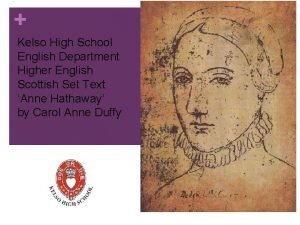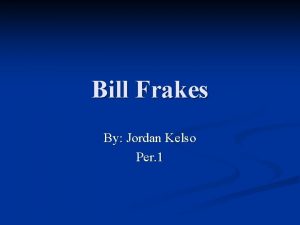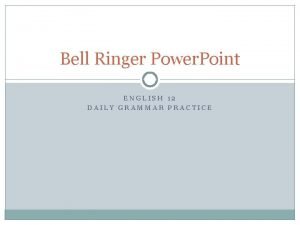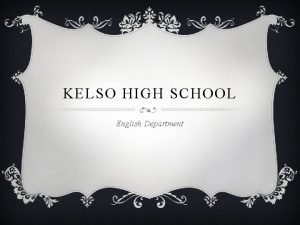Kelso High School English Department Higher English Scottish






















- Slides: 22

+ Kelso High School English Department Higher English Scottish Set Text ‘Anne Hathaway’ by Carol Anne Duffy

+ Learning objectives: in today’s lesson we will: n Revise ‘Anne Hathaway’ by Carol Anne Duffy n Revise our understanding of the form of the poem n Revise our understanding of the effectiveness of poetic techniques used within the poem

+ This poem: • This poem is taken from a collection by Carol Ann Duffy called “The World’s Wife”. • In this collection, Duffy writes a number of dramatic monologues from the perspective of women who have been traditionally silenced in history, mythology and fiction. • The monologues are essentially giving a voice back to these women, and at the same time allowing us to see the men in their lives from a different view point.

+ Who was Anne Hathaway? She married William Shakespeare in 1582. Anne was 26 when she married Shakespear e, he was 18. Little is known about her – no contemporary paintings exist. Anne Hathaway came from a wealthy family in Stratford-upon. Avon She was 6 months pregnant with their first child when she married Shakespeare. Whilst Shakespeare lived and worked in London as a playwright, she stayed in Stratford with their three children (Susanna, Hamnet and Judith).

+ Anne Hathaway • Like Mrs Midas, this poem gives voice to and empowers the female figures from the narrative of our past – looking to the female perspective.

+ Treasured possessions n The poem is about an item that Shakespeare leaves his wife in his Last Will and Testament after his death. Item I gyve unto my wife my second best bed …

+ Shakespeare’s Will n n “Item I gyve unto my wife my second best bed…” How would you feel if you were Anne? Is that it? ? ? Thank you. I’m very grateful!

+ Shakespeare’s Will • When Shakespeare died, the only present he left his wife in his will was the second best bed in the house. Many scholars have seen this as confirmation that the couple had become estranged, and that this parting gift was meant to be a snub on Shakespeare’s part. • There has been much speculation about the great loves and muses in Shakespeare’s life but very few people think that Anne Hathaway was one of them. • In the film Shakespeare in Love Anne Hathaway, whom we never see, is nothing more than an inconvenience to her husband, getting in the way of his search for a true muse who will inspire him to produce a masterpiece. n In this poem, however, Duffy, makes us question the relationship between Anne Hathaway and Shakespeare, and the wife’s contribution to the work of her husband.

+ Contrary to initial thoughts… § The best beds were reserved for guests suggesting that their second best bed was their own marital bed. n While some critics have viewed this as an insult, Duffy imagines that Shakespeare’s legacy of leaving the bed to his wife was his last romantic gesture. n Within the poem the bed is a METAPHOR for the intense passion and romance shared by the couple.

+ Contrary to initial thoughts… § Anne Hathaway’s version of events reveals that she was very much in love with her husband. Theirs was a marriage of equality. § He left her his second best bed because it was the one in which they had enacted in a very real sense the drama of their relationship. § Carol Ann Duffy reimagines the gift of the second best bed, not as a petty demonstration of marital discontent, but as the place where husband wife experienced their most romantic and intimate moments.

+ Read the Poem n n n Think about who the narrator is Think about what the poem is about. Think about themes that are conveyed in this poem.

+ Themes / Main ideas n Love / Passion n Loss / Death / Rememberance n Literature / Writing

+ Form of the poem n Sonnet spoken in the voice of Anne Hathaway n As Duffy imagines the speaker as one distinct character, we call this poem a dramatic monologue. n Poem follows most basic sonnet rule - fourteen lines and final rhyming couplet. n Written mostly in iambic pentameter. n Sonnets are often associated with theme of love. n The sonnet form was regularly used by Shakespeare. n While she keeps the rough outline of the sonnet (three quatrains), Duffy does not use the traditional rhyme scheme that all Shakespearian sonnets follow: ABAB CDCD EFEF GG. § Identify the rhyming scheme of this poem. Does it follow this pattern? § Duffy takes and changes the traditional sonnet form used by males to declare their love, for her own use to express the power of her female character.

+ Why does the speaker (Hathaway) chose to narrate her thoughts in the form of a sonnet? § As a tribute to her husband who devoted to life to producing sonnets and poetry. § To represent her love for her husband. Remember a sonnet is often associated with theme of love? § To help create a realistic speaking voice. The rhythm involved in iambic pentameter is often said to mimic the natural speaking voice. § Perhaps the fact it is not a perfect sonnet is a tribute in itself? It is as if Hathaway is saying to her late husband that only he is capable of creating a perfect sonnet.

+ Epigraph n The poem begins with the actual extract from Shakespeare’s will. Although some critics consider this an insult to Hathaway, Duffy uses it as the catalyst for the poem and gives the bed a much more magical and sensual meaning. Item I gyve unto my wife my second best bed …

+ Quatrain 1 illustrates intensity of their romantic passionate relationship Past tense / Word Choice 1. The bed we loved in was a spinning world 3. Word Choice / Connotation of forests, castles, torchlight, clifftops, seas 4. 2. Metaphor / Connotation 5. Word Choice / Assonance. Metaphor where he would dive for pearls. My lover’s words were shooting stars which fell to earth as kisses 7. Metaphor 8. Sibilance and assonance 6. Enjambment

+ Quatrain 2 – extends the language metaphor. 9. Extended metaphor 10. Word Choice on these lips; my body now a softer rhyme to his, now echo, assonance; his touch 11. Enjambment 12. Personification a verb dancing in the centre of a noun. Some nights, I dreamed he’d written me, the bed 14. 13. Word Choice Positioning

+ Quatrain 3 15. Metaphor. a page beneath his writer’s hands. Romance and drama played by touch, by scent, by taste. 18 . Word Choice In the other bed, the best, our guests dozed on, 19. Word Choice / Tone 20. Word Choice / Connotation / Alliteration dribbling their prose. My living laughing love - 21. Alliteration / Assonance 22. Dash 16. Enjambment 17. Word Choice

+ Couplet 23. Metaphor I hold him in the casket of my widow’s head as he held me upon that next best bed. 24. Word Sound Choice / 25. Rhyme

+ Notable Techniques • Sonnet form • Metaphors – used to connect the world of Shakespeare’s poetry with the physical reality of his marriage to Anne. • Imagery • Sound • Contrast • Word Choice • Enjambment • Rhyme – rhyme / masculine rhyme / feminine rhyme

+ Tone • Reflective • Sensual

+ Links with other poems: n ‘Havisham’ - both tell the story of a woman’s life after love. This is in contrast to another poem by Carol Ann Duffy, “Havisham”, where Miss Havisham from Great Expectations remains bitter and vengeful towards the lover who jilted her. There is no such anger or resentment in this poem, only a widow grieving a beloved husband. n ‘Mrs Midas’ – Both have a famous spouse – the woman’s perspective. “Anne Hathaway” allows us a different perspective of Shakespeare, a man sometimes represented as a philandering husband who put his writing above all else. We instead perceive him as a devoted husband, who saw writing not as something separate to marriage, but as something deeply embedded within it. Therefore another key theme in the poem is the true identity of William Shakespeare, a man about whom scholars still know surprisingly little. n ‘Valentine’ – Unusual perspective of poet – Love.
 Gordon watson chemistry
Gordon watson chemistry Gordon watson ap chemistry
Gordon watson ap chemistry Gordon watson chemistry
Gordon watson chemistry Gordon watson chemistry
Gordon watson chemistry Kelso high school chemistry
Kelso high school chemistry Leadership styles in childcare
Leadership styles in childcare Scottish english features
Scottish english features Kelso's choices
Kelso's choices Gordon kelso chemistry
Gordon kelso chemistry Ts kelso
Ts kelso Central welding supply kelso wa
Central welding supply kelso wa Bill frakes
Bill frakes Department of higher education and training
Department of higher education and training Ohio department of higher education
Ohio department of higher education Crescenta valley high school summer school
Crescenta valley high school summer school Haltom high school summer school
Haltom high school summer school Our own english high school sharjah boys
Our own english high school sharjah boys Literary criticism lenses
Literary criticism lenses English 12 grammar
English 12 grammar Traditional scottish instruments
Traditional scottish instruments Medical defence union of scotland
Medical defence union of scotland Scottish patient safety programme
Scottish patient safety programme Srtp radiology
Srtp radiology











































